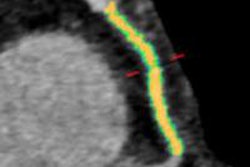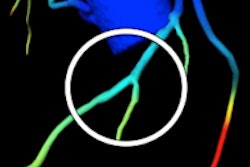Total plaque volume at coronary CT angiography (CCTA) is a more reliable predictor of stenosis than luminal narrowing -- to the point where it could help differentiate between patients who have stenosis detected on CCTA and the smaller number with true flow-limiting lesions that need treatment, wrote researchers in the Journal of the American College of Cardiology.
Vessels with intermediate lesions at CCTA are the ones whose patency is most difficult to discern. In an analysis of 58 patients with intermediate lesions who underwent CCTA, invasive coronary angiography, and fractional flow reserve CT, the 22 patients with ischemia at angiography had smaller minimal lumen diameters and minimal lumen area at CCTA compared to the other patients. However, ischemia was correlated most closely with aggregate plaque volume, according to the researchers from Cedars-Sinai Medical Center.
"We observed that percent aggregate plaque volume allowed for diagnosis of lesion-specific ischemia of intermediate stenoses in a manner that surpasses more traditional angiographic measures of [coronary artery disease (CAD)] lesion severity and that, when combined with them, offer independent and incremental discriminatory power," wrote Dr. Ryo Nakazato, PhD; Dr. Aryeh Shalev; Dr. James Min; and colleagues. "The robustness of percent aggregate plaque volume as an important marker of ischemia was evident for all analyses, including diagnosis, correlation, discrimination, and reclassification" (JACC, May 28, 2013).
Increasing prevalence
The extent of mild angiographic narrowing of the lumen is tied to increasing prevalence and severity of global myocardial ischemia by myocardial perfusion imaging; however, the degree to which different measures of coronary atherosclerosis contribute to this phenomenon is unknown, the authors wrote. Better methods are needed to evaluate the severity of coronary stenosis at CTA.
"The present method just takes the [site] of greatest luminal narrowing and uses that as a surrogate marker for whether or not a lesion is obstructive or nonobstructive," as measured either anatomically, or physiologically in the restriction of blood flow. Prior studies suggest that the physiologic reduction in blood flow is the more important measure for predicting myocardial ischemia and infarction, Min explained in an interview with AuntMinnie.com.
"Any anatomic method that might enhance the diagnosis of ischemia-producing lesions would be of great value," he said. "What we hypothesized was that it was not only the site of the greatest luminal narrowing that was important for the identification of vessels that manifest ischemia, but that it would be the aggregate atherosclerotic plaque from the osteum of the vessel to the distal portion of the most stenotic plaque" that was most predictive.
Moreover, the association of coronary atherosclerosis to ischemia has yet to be studied on a lesion-by-lesion basis. The study aimed to address these issues by looking at CCTA measures of luminal arterial narrowing as well as cumulative coronary atherosclerotic plaque burden to determine the best diagnostic methods for finding ischemia-causing lesions of intermediate stenosis severity. The various measures of vessel obstruction were evaluated in comparison to invasive fractional flow reserve (FFR).
The authors identified 58 patients with intermediate coronary artery lesions (30%-70% diameter stenosis) who underwent invasive angiography and fractional flow reserve. CCTA and FFR were separated by 21 days at most, with no intervening coronary events, the group reported.
Coronary CTA scans were performed using either dual-source CT (Somatom Definition, Siemens Healthcare) or 320-detector-row CT (Aquilion One, Toshiba America Medical Systems) following administration of sublingual nitroglycerine, iodinated contrast (Omnipaque 350 mg/dL, GE Healthcare), and beta-blockers for those with heart rates faster than 65 beats per minute. Scan settings included 0.625-mm collimation, 350 mAs, and tube voltage of 100 or 120 kVp.
Tube current modulation and prospective gating were used whenever possible, and transaxial images were reconstructed with 0.6- to 0.75-mm slice thickness and 0.3- to 0.4-mm slice increments.
Coronary CTA measures of stenosis included diameter stenosis, area stenosis, minimal lumen diameter (MLD), minimal lumen area (MLA), and the aggregate plaque volume (%APV, defined as the sum of plaque volume divided by the sum of vessel volume from the osteum to the distal part of the lesion).
Fractional flow reserve of 0.80 or less was used to diagnose lesion-specific ischemia, and the group measured the area under the receiver operator characteristics curve (AUC) and net reclassification improvement of the measurement methods.
The results showed that 22 (38%) of the 58 lesions caused ischemia, according to the researchers. Compared with nonischemic lesions, ischemic lesions had smaller MLD (1.3 vs. 1.7 mm, p = 0.01), smaller MLA (2.5 vs. 3.8 mm2, p = 0.01), and greater %APV (48.9 vs. 39.3, p < 0.0001).
By far, AUC was highest for %APV (0.85), compared with diameter stenosis (0.68), area stenosis (0.66), MLD (0.75), and MLA (0.78). Adding %APV to other measures showed significant reclassification over diameter stenosis, area stenosis, MLD, and MLA.
However, while %APV trended toward improved discriminatory power over MLA (0.89 vs. 0.78 for MLA), it did not significantly improve it (p = 0.07).
Analyzed using multivariable logistic regression analysis, %APV again came in first, remaining as a significant predictor for lesion ischemia compared to diameter stenosis (odds ratio, 1.28; 95% confidence interval [CI]: 1.12-1.47; p < 0.001), area stenosis (odds ratio, 1.29; 95% CI: 1.12-1.49; p < 0.001), MLD (odds ratio, 1.26; 95% CI: 1.11-1.43; p < 0.001), and MLA (odds ratio, 1.27; 95% CI: 1.10-1.47; p < 0.001).
Correlations between FFR values and diameter stenosis were significant and moderate. There was no correlation of percent aggregate plaque volume and lesion length.
"What we further found is that if you add %APV to these traditional angiographic measures such as diameter stenosis, it was significantly additive to identify the specific coronary lesions or vessels that manifest ischemia -- and it's a much stronger measure of ischemia than any luminal percent stenosis measure alone," Min said.
Thus, the combined use of %APV and conventional measures of luminal narrowing "may represent a more ideal approach to identifying lesions that cause ischemia," the authors concluded.
Robust as the results are, they don't mean that plaque volume measurements at CCTA are going to be able to identify ischemia by itself, Min cautioned. "I think it's going to be additive," he said. "This is an anatomic measure of atherosclerotic plaque, and I think it is novel, but it will be complementary to physiologic measures such as FFR CT."
Another important question is whether or not increased aggregate plaque volume heightens the risk of future adverse events, such as myocardial infarction or sudden cardiac death. "And we're assessing the first one right now -- whether [plaque volume] really does affect the prognosis of people going forward," Min said.
The next study will also be on a larger scale, looking at more than 300 patients in a multicenter effort. "We're also looking at more than 300 patients for prediction of incident myocardial infarction," he said.



















